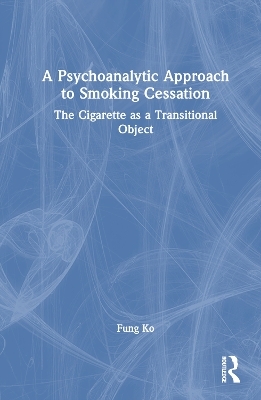
A Psychoanalytic Approach to Smoking Cessation
Routledge (Verlag)
978-1-032-35867-3 (ISBN)
The book is divided thematically into six parts. Ko begins by outlining the conscious motives for smoking from a psychological perspective and looks at commercial research conducted by the tobacco industry, before using psychoanalytically informed cross-disciplinary literature to assess the unconscious motives for smoking. She expertly introduces Winnicott’s view on smoking addiction, using his concept of the transitional object, and highlights the power of the Free Association Narrative Interview method in accessing the unconscious and embedded emotional experiences. Using clinical examples, she illustrates the benefits of this method as a tool to elicit free associations from research respondents. She details the parallels between the individual respondents’ smoking experience, as well as their relationship with cigarettes and the seven qualities of transitional objects outlined by Winnicott in his 1953 landmark paper. Ko concludes by emphasising the significance and implications of this thesis to smokers and public health policy, as well as the smoking cessation approach and proposed directions for future research.
This book is an essential resource for psychoanalysts and psychotherapists working in smoking cessation organisations, as well as those working in addiction services.
Fung Ko holds a PhD in Psychoanalytic Studies from the University of Essex, UK. She has 30 years of experience in multinational consumer goods companies marketing ‘pleasure food’. Her psychoanalytic research focuses on Winnicott's concept of the transitional object to give understanding to tobacco addiction.
About the author
Foreword
Acknowledgements
Introduction
PART I
What are the conscious motives for smoking?
1 What do the psychologists think?
2 What do the tobacco boys think?
PART II
What are the unconscious motives for smoking?
3 Ernest Dichter’s ‘Motivation Research’
4 Psychoanalytic understanding
5 Psychoanalytically informed cross-disciplinary perspectives
PART III
What does smoking addiction have to do with Linus’s security blanket?
6 D. W. Winnicott: who was he?
7 What are his major contributions to psychoanalysis?
8 What is his view on smoking addiction?
PART IV
Which research approach has the power to access the unconscious?
9 Quantitative survey-based research?
10 Qualitative interview-based research?
11 The narrative interviewing approach?
12 The Free Association Narrative Interview (FANI) method!
13 What does our research approach look like?
PART V
The shadow of the transitional object fell upon the cigarette
14 Our respondents – what are their stories?
15 Spotting the ‘regressive’ smoking moments
16 The resemblance of a cigarette to the transitional object
PART VI
So what?
17 Implications for smokers and public health policy
18 Proposed directions for future research
References
Index
| Erscheinungsdatum | 20.12.2023 |
|---|---|
| Zusatzinfo | 5 Tables, black and white |
| Verlagsort | London |
| Sprache | englisch |
| Maße | 156 x 234 mm |
| Gewicht | 508 g |
| Themenwelt | Geisteswissenschaften ► Psychologie ► Psychoanalyse / Tiefenpsychologie |
| Medizin / Pharmazie ► Medizinische Fachgebiete ► Psychiatrie / Psychotherapie | |
| Medizin / Pharmazie ► Medizinische Fachgebiete ► Suchtkrankheiten | |
| ISBN-10 | 1-032-35867-X / 103235867X |
| ISBN-13 | 978-1-032-35867-3 / 9781032358673 |
| Zustand | Neuware |
| Haben Sie eine Frage zum Produkt? |
aus dem Bereich


